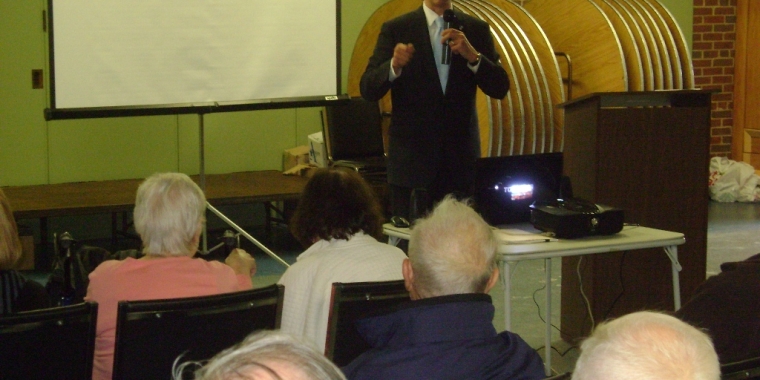From the Desk of Senator Jack M. Martins
Jack M. Martins
March 19, 2012
-
ISSUE:
- Local Government
-
COMMITTEE:
- Local Government
Cutting Through the Baloney
This past week saw the state legislature, Senate and Assembly, work with the Governor to pass significant legislation and reforms in what is being hailed as a week of momentous initiative. Unfortunately, no matter how much was positively accomplished, there will always be special interests that focus on the negatives and attempt to diminish the accomplishments as insufficient to their cause.
The fact is no legislation is ever perfect and I’ve shared my own concerns a number of times with you in the past. That being said, our goal is bi-partisan progress, no matter how incremental. We can’t afford to keep taxpayers forever mired in the mud. And to be honest, this was a pretty big week so I’d like to offer an overview of what we were able to achieve while addressing some criticisms you might have heard.
Pension Reform: Skyrocketing pension costs have drained the budgets of our school districts and local governments. All else aside, the fact remains that since 2001, pension contributions by state, local governments and schools shot up from $368 million to $6.6 billion. When the stock market slumps, the system requires you, the taxpayer, to fix public pensions by paying more just when the economy is at its worst. No sane person will tell you that this rate is sustainable or fair.
The new system, Tier VI, does not impact any current employees or retirees. It applies only to future employees, raising the retirement age from 62 to 63, lengthening the time period for final average salary calculation from 3 to 5 years and offering an optional defined contribution plan for new non-union employees, which is common in the private sector. In addition, the new tier asks for greater participation from the employees themselves, but is still very reasonable. The contribution rate will be 3.5% for future employees earning $45,000-$55,000, 4.5 % for $55,000-$75,000, 5.75 % for $75,000-$100,000, and 6 % percent for employees making over $100,000.
Naturally, there were critics on both sides with unions saying it was too drastic and some conservative groups exclaiming we didn’t go far enough. Regardless, this historic middle ground is still very generous but is expected to save us $80 billion over 30 years, while avoiding possible insolvency.
DNA Databank: We also passed a measure creating the country’s first “all crimes” DNA Databank. Previous state law allowed DNA to be collected from only 48 percent of those convicted of a penal law crime. Samples will now be collected in any felony or misdemeanor conviction. Assembly Democrats fairly called for defendants to have broader access to the data, and that was enacted as well. Manhattan District Attorney Cy Vance stated that our new law “will not only help convict the guilty and bring closure to thousands of victims in unsolved cases, it will exonerate the innocent.”
Casinos: This was an area of particular concern for me. Our state constitution currently prohibits gambling and, as such, must be amended in order to legalize casinos in our state. Amendments are achieved when the legislature approves a measure for two consecutive years at which point it is voted on in a statewide referendum. While we agreed to this first approval, the Governor’s proposal lacks specific details on where casinos may be located. Some areas desperately need the economic boost, others are not conducive to a casino. As I stated on the Senate floor, without specific details available next year, I will vote against continuing the process.
Some critics felt the idea should not even be entertained but truth is we already have gambling in New York: horse racing, lotteries, bingo, racinos and even Indian Reservation casinos, but no gaming commission to provide needed oversight. Furthermore, anyone who wants to gamble will simply bring that revenue to outlets all around us in New Jersey, Connecticut and even Pennsylvania. As the agreement would see no more than seven casinos allowed in the state, I felt it was fair to allow the discussion to continue.
Bottom line – even if the proposal manages to pass both houses of the legislature in two successive years, it must still be approved by statewide public referendum.
Redistricting: Redistricting happens every ten years based on census data. The state constitution places the task of redistricting squarely on the legislature which inherently raises issues of conflict. With our vote this past week we finally kick started the process of reforming the system permanently. The plan is to amend the state constitution and create an independent commission to draw future lines thereby removing the legislature from the process. The independent commission will include appointees from both the Senate and Assembly, ensuring that the process receives bi-partisan input. As it proposes amending the constitution, it will require a second vote next year as well as a statewide public referendum. This undertaking received the support of the Governor, the Senate and the Assembly.
Many special interest groups had lobbied to change the redistricting process legislatively, ignoring the realities that our state constitution imposes. A permanent solution, which removes the legislature from the process, requires the constitutional amendment which we put in motion. Through this measure, the matter has been resolved so that future redistricting will not have to wrestle with these issues. In any case, our own 7th Senate District remains virtually unchanged.
When you sent me to Albany, I promised that hard-working, honest people could fix anything if we rolled up our sleeves and came together. I think it’s been a tough slog but we’re truly moving the state forward. It’s the nature of compromise, balancing interests and needs from across the state to get things done.
Share this Article or Press Release
Newsroom
Go to NewsroomWalter Blum
May 17, 2014

